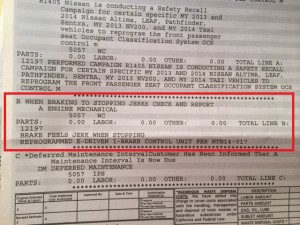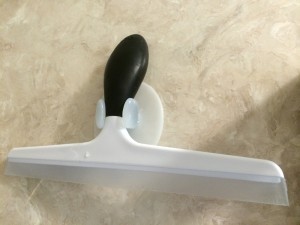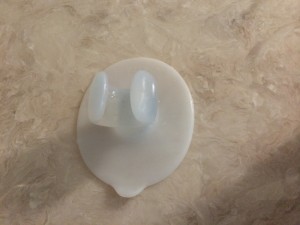For several months now since I had my regular maintenance done on my 2013 Nissan Leaf, I have been experiencing very jerky brakes – sudden stop and jerk forward – driving my car. It’s like having an automatic-transmission car with super-fast idle speed and a digital(on/off) brake system. I felt bad as my passengers (my wife and daughter) kept complaining that I drove like a novice driver and it’s making them car sick. But no matter how hard I tried to soft peddle the brake, I would end up braking too short and when I let go slightly the car would jerk forward then stop. Or it would end up braking too slowly and I had to brake hard to avoid rear ending the car in front of me. It was an annoying and frustrating couple of months. I asked other Leaf owners, none of them experienced the same problem.
I decided to bring the car to the dealership last Saturday (5/30/14) and was prepared to leave it there until Monday if necessary as the “Master Tech” wasn’t on duty to diagnose this complicated problem.
Within 2 hours I got a call from Paul, the service adviser in Stevens Creek Nissan Dealership that the problem has been fixed with the “reprogramming of the E-driven I-Brake Control Unit; it was in the service bulletin.” See invoice below:

Wow, little did I know that the braking system nowadays are more or less run by an on-board computer. That’s amazing!
Now the car is back to normal and I’m enjoying driving my Nissan Leaf again, zipping through the freeway during traffic hours on the “carpool” lane, to and from work. 😉
A couple of things I learned from this experience:
1. If you encounter any car problems, search on Internet if there’s already a “service bulletin” outstanding that can address your specific car problem. I found that I could have found it on Internet and brought it to the dealership earlier instead of experiencing months of embarrassment. Make sure you have your car year/model and “service bulletin” key words. For example, for me it’s “nissan leaf 2013 service bulletin brake” for the Google search string.
2. More and more of the modern car or household appliances are run by computer. The upside is that the fix may be just a simple software upgrade and you’re back in business. The downsize that as the car is increasingly connected to the Internet as my Nissan Leaf is connected via 3G network, there may be more security/safety issues if someone can practically hack into your on-board car computer and cause a serious safety problem, e.g. by disabling the brake when you’re cruising on the freeway, and etc. The consequences could be deadly. It’s something we engineers need to pay special attention in our design work.



